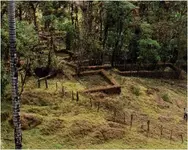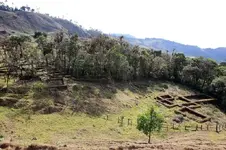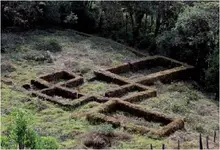Crow
Silver Member
- Joined
- Jan 28, 2005
- Messages
- 4,040
- Reaction score
- 11,243
- Golden Thread
- 0
- Location
- In a tax haven some where
- Detector(s) used
- ONES THAT GO BEEP! :-)
- Primary Interest:
- Other
- #1
Thread Owner
Ah it appears you can thank Culinary caveman for making old Crow tell the following yarn....
Hmm it seems I am not the only one that likes to fish ?
?
So grab a beer, coffee and a bar stool get comfortably as the Sly devil threw me a curved ball. Such a strange and unusual request about a place 99% would not even know to exist? old Crow the curious old bedraggled bird I am is curious to know how ya know about such a little known site?
Before 1999 the site was just about open slaver many treasure hunters scoured the little known ruins for alleged gold artifacts interwoven with the local Indian population and the Incas. Many allegedly smuggled out of the country.
To the inhabitants of the ruins of Atahualpa yacuviñay have more of a story. Many say that the site is a place of mysteries, night cries, an ancient place of funerals and even claims of gold objects have been allegedly found in the grounds?
Teresa Castillo, Atahualpa resident for over 50 odd years, says that sites origins was of Yacuviñay people and not the Incas from the 16th century. Archaeologists have investigated its origins have another interpretation. Dr. Jaime Hidrovo, director of Andean Civilization, the entity that made the first step of recovering the ruins foundation ensures Yacuviñay traits reveals the presence of the Incas in the fifteenth and sixteenth centuries between 1470 and 1530, time when the empire collapsed occurs. In this period the site served as Inca's camp was also used as a strategic point for communication with Aboriginal cultures in complex Canaris Pucara viewpoint and indigenous populations Saraguro in Loja. Hidrovo also confirms that even his name is Inca origin: Yacu meaning "water or river" and Vinay "forever", ie Yacuviñay is the representation of eternal water and this confirms that the sector has several hydrological vertices.
Ah here is where it gets interesting..
The extensive archaeological complex has a special detail in the most elevated area of the ruins there is a deep cave where, according to the beliefs of the people, are the remains of people, pottery and metal. Perhaps even hidden gold ?
?
There archaeologists have not yet done any exploration, however native industry reaffirm his testimony by showing the objects found as clay figures and parts of human skeletons. In the visible region, divided the Yacuviñay complex into 5 distinct areas
1) El Mirador
2) Cruciform structures
3) Residential space
4) Uzhnu
5) Temple Catequila
There are also sub lagoon as ninety feet in diameter located on the right side of the complex claerly used for irrigation, two bodies of terrace, large and five small square.
According to Dr. Jaime Hidrovo, large residential complexes used them chiefs and bureaucrats, while small were recreation space Inca popular class. Another peculiar feature is the existence of two bathrooms with natural spring, for public use small and large, with a length of one meter in diameter and three meters high, this was exclusively used by the Inca elite.
So in essence they site was originally a site of the Yacuviñay people some time before the conquest was transformed into a Inca military site.



Could this cave have a fortune in treasure awaiting discovery? Such is the lure of lost cities and the lure of hidden gold.
Crow
Hmm it seems I am not the only one that likes to fish
 ?
?So grab a beer, coffee and a bar stool get comfortably as the Sly devil threw me a curved ball. Such a strange and unusual request about a place 99% would not even know to exist? old Crow the curious old bedraggled bird I am is curious to know how ya know about such a little known site?
Before 1999 the site was just about open slaver many treasure hunters scoured the little known ruins for alleged gold artifacts interwoven with the local Indian population and the Incas. Many allegedly smuggled out of the country.
To the inhabitants of the ruins of Atahualpa yacuviñay have more of a story. Many say that the site is a place of mysteries, night cries, an ancient place of funerals and even claims of gold objects have been allegedly found in the grounds?
Teresa Castillo, Atahualpa resident for over 50 odd years, says that sites origins was of Yacuviñay people and not the Incas from the 16th century. Archaeologists have investigated its origins have another interpretation. Dr. Jaime Hidrovo, director of Andean Civilization, the entity that made the first step of recovering the ruins foundation ensures Yacuviñay traits reveals the presence of the Incas in the fifteenth and sixteenth centuries between 1470 and 1530, time when the empire collapsed occurs. In this period the site served as Inca's camp was also used as a strategic point for communication with Aboriginal cultures in complex Canaris Pucara viewpoint and indigenous populations Saraguro in Loja. Hidrovo also confirms that even his name is Inca origin: Yacu meaning "water or river" and Vinay "forever", ie Yacuviñay is the representation of eternal water and this confirms that the sector has several hydrological vertices.
Ah here is where it gets interesting..
The extensive archaeological complex has a special detail in the most elevated area of the ruins there is a deep cave where, according to the beliefs of the people, are the remains of people, pottery and metal. Perhaps even hidden gold
 ?
?There archaeologists have not yet done any exploration, however native industry reaffirm his testimony by showing the objects found as clay figures and parts of human skeletons. In the visible region, divided the Yacuviñay complex into 5 distinct areas
1) El Mirador
2) Cruciform structures
3) Residential space
4) Uzhnu
5) Temple Catequila
There are also sub lagoon as ninety feet in diameter located on the right side of the complex claerly used for irrigation, two bodies of terrace, large and five small square.
According to Dr. Jaime Hidrovo, large residential complexes used them chiefs and bureaucrats, while small were recreation space Inca popular class. Another peculiar feature is the existence of two bathrooms with natural spring, for public use small and large, with a length of one meter in diameter and three meters high, this was exclusively used by the Inca elite.
So in essence they site was originally a site of the Yacuviñay people some time before the conquest was transformed into a Inca military site.



Could this cave have a fortune in treasure awaiting discovery? Such is the lure of lost cities and the lure of hidden gold.
Crow
Last edited:



 I have a T-shirt if found please return to bar
I have a T-shirt if found please return to bar
